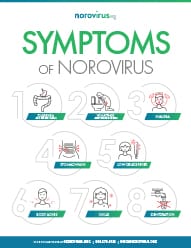Norovirus is a highly contagious virus that primarily causes gastroenteritis, an inflammation of the stomach and intestines. It is often associated with outbreaks in crowded environments such as schools, nursing homes, and cruise ships. As the number of reported cases rises, it is essential for individuals to be informed about the symptoms of norovirus and the preventive measures that can be taken to reduce the risk of infection.
The symptoms of norovirus typically appear 12 to 48 hours after exposure to the virus. Common symptoms include sudden onset of vomiting, watery diarrhea, stomach cramps, and nausea. Some individuals may also experience fever, headache, and muscle aches. The symptoms can be severe, particularly in vulnerable populations such as young children, the elderly, and those with weakened immune systems. Most people recover within one to three days, but dehydration can occur, necessitating medical attention in some cases.
Norovirus spreads through several routes, including direct contact with an infected person, consuming contaminated food or water, and touching surfaces or objects contaminated with the virus. It is important to note that norovirus can survive on surfaces for extended periods, making thorough cleaning and disinfection crucial in preventing outbreaks.
To reduce the risk of contracting norovirus, individuals should practice good hygiene. Regular handwashing with soap and water is one of the most effective ways to prevent the spread of the virus. Hand sanitizers may not be sufficient, as they do not eliminate all types of germs, including norovirus. It is particularly important to wash hands after using the restroom, before preparing or eating food, and after caring for someone who is ill.
In addition to hand hygiene, food safety practices are essential in preventing norovirus infections. Individuals should ensure that food is cooked to the appropriate temperatures and that fruits and vegetables are washed thoroughly before consumption. It is also advisable to avoid consuming raw or undercooked shellfish, which are common sources of norovirus outbreaks.
Cleaning and disinfecting surfaces that may be contaminated is another key aspect of prevention. High-touch surfaces such as countertops, doorknobs, and bathroom fixtures should be cleaned with a bleach-based cleaner or other effective disinfectants. If someone in the household is infected, it is crucial to isolate them and ensure that shared spaces are cleaned frequently to minimize the risk of transmission.
Health officials emphasize the importance of staying home when experiencing symptoms of norovirus. Individuals should avoid preparing food for others and refrain from attending work, school, or social gatherings until at least 48 hours after symptoms have resolved. This is particularly important in preventing the spread of the virus in communal settings.
If an individual suspects they have contracted norovirus, it is advisable to stay hydrated by drinking clear fluids. Oral rehydration solutions can help replenish lost fluids and electrolytes. In cases of severe dehydration, medical attention may be necessary, especially for vulnerable populations.
The rise in norovirus cases serves as a reminder of the importance of public health awareness and personal responsibility in preventing the spread of infectious diseases. By understanding the symptoms and implementing effective prevention strategies, individuals can help protect themselves and those around them from this highly contagious virus.
In conclusion, norovirus continues to pose a significant public health challenge, particularly during the colder months when outbreaks are more common. By being vigilant about hygiene practices, food safety, and recognizing the symptoms of infection, individuals can play a crucial role in curbing the spread of norovirus. Staying informed and taking proactive measures is essential in safeguarding personal health and the health of the community.



